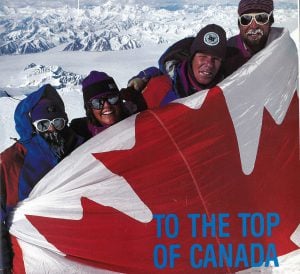
Exploration
The pull of Everest
A century after a Canadian was instrumental in charting the world's highest peak, a fellow Canadian reflects on the magnetism of Everest
- 4083 words
- 17 minutes
This article is over 5 years old and may contain outdated information.
Exploration

Freezing temperatures and a gear-planning error have combined to force two climbers to abandon their attempt to summit Canada’s fifth-highest mountain.
Lonnie Dupre and Pascale Marceau had to leave Mount Steele, a 5,067-metre peak located in the northwest corner of Kluane National Park and Reserve, after realizing that their sleeping-bag system wasn’t working properly. The duo were flown out on Wednesday and are now in Haines Junction.
The sleeping-bag system they were using consists of a vapour-barrier liner, which keeps moisure out of a down-filled sleeping bag, which is in turn covered by a lighter, synthetic sleeping bag. “The vapour-barrier liners had degraded and we mistakenly took down bags that had Gore-Tex covers, which prevented the residual moisture from escaping the bag,” said Dupre. “If that moisture can’t escape, it freezes, and we get cold.” In a blog post on Monday, Dupre and Marceau’s support team noted that temperatures on the mountain felt like – 42 C. “We were shivering all through the last night on the mountain and knew that if we kept going, it could have been dangerous,” said Dupre.
Dupre said that the sleeping bags were not 100 per cent useless, but that he and Marceau had to make the call to end the expedition when they knew the bags weren’t going to keep them warm. “When you’re at 12,000 feet on Mount Steele in January, that makes a difference when you’re trying to decide whether to keep going or to stay warm.”
In a video posted to his YouTube account on Monday, Dupre described the conditions he and Marceau had been facing. “We are currently pinned down at 12,000 feet, and we’ve been pinned down for the last 30 hours. It’s been blowing at about 30 knots [about 56 km/h] and the tent’s holding up beautifully, but it’s a little wearing on the psyche to be sitting in a tent being pounded by the wind for that long. We’re waiting for a lull in the storm so we can move to a better location because we got kind of caught with our pants down in a location where the wind tends to funnel…. We can’t go up, we can’t go down, we can’t do anything at the moment.”
It’s the second time in just over a week that poor conditions have forced Dupre and Marceau to change their plans. On Jan. 19 they canceled their attempted ascent of their initial target, Mount Lucania, Canada’s third-highest mountain at 5,226 metres, because of crevasses and a lack of good landing spots at lower elevations. If they had been successful, it would have been the first time climbers had summitted the peak in winter.
“When you’re doing first winter ascents like this, there’s always a learning curve,” said Dupre. “We had trouble with the approach route for Lucania, and then this gear snafu. But we’re going to come back to try Lucania in 2019.”
Are you passionate about Canadian geography?
You can support Canadian Geographic in 3 ways:

Exploration
A century after a Canadian was instrumental in charting the world's highest peak, a fellow Canadian reflects on the magnetism of Everest

Exploration
In 1992, a team backed by The Royal Canadian Geographical Society became the first to accurately measure the height of Mount Logan, Canada’s highest peak

Environment
They sustain us, enrich our lives and inspire us

Travel
An insider’s account of the modern-day gold rush